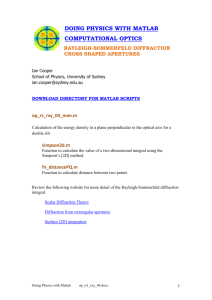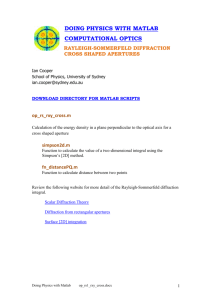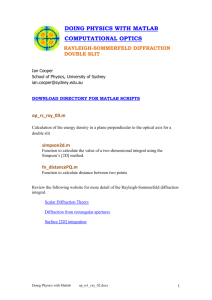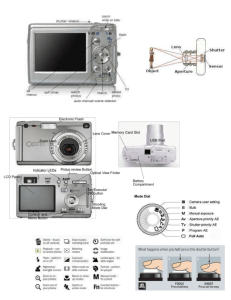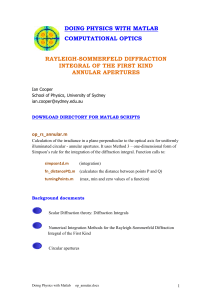op_rs1_rxy_01 - School of Physics
advertisement
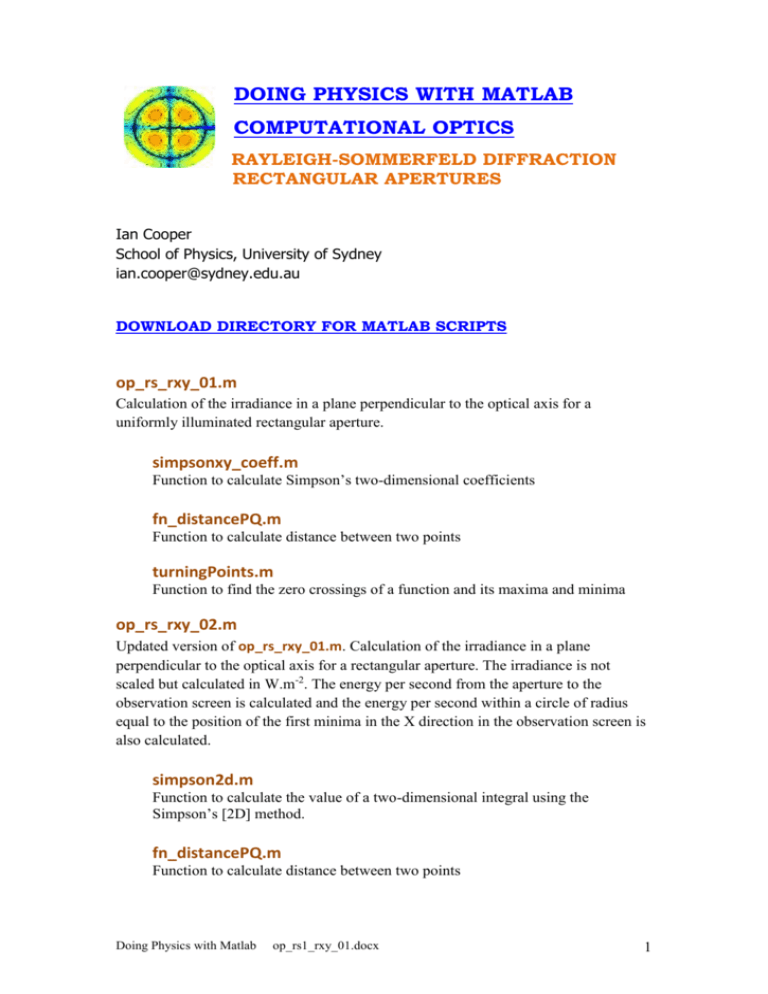
DOING PHYSICS WITH MATLAB COMPUTATIONAL OPTICS RAYLEIGH-SOMMERFELD DIFFRACTION RECTANGULAR APERTURES Ian Cooper School of Physics, University of Sydney ian.cooper@sydney.edu.au DOWNLOAD DIRECTORY FOR MATLAB SCRIPTS op_rs_rxy_01.m Calculation of the irradiance in a plane perpendicular to the optical axis for a uniformly illuminated rectangular aperture. simpsonxy_coeff.m Function to calculate Simpson’s two-dimensional coefficients fn_distancePQ.m Function to calculate distance between two points turningPoints.m Function to find the zero crossings of a function and its maxima and minima op_rs_rxy_02.m Updated version of op_rs_rxy_01.m. Calculation of the irradiance in a plane perpendicular to the optical axis for a rectangular aperture. The irradiance is not scaled but calculated in W.m-2. The energy per second from the aperture to the observation screen is calculated and the energy per second within a circle of radius equal to the position of the first minima in the X direction in the observation screen is also calculated. simpson2d.m Function to calculate the value of a two-dimensional integral using the Simpson’s [2D] method. fn_distancePQ.m Function to calculate distance between two points Doing Physics with Matlab op_rs1_rxy_01.docx 1 FRAUNHOFER DIFFRACTION – RECTANGULAR APERTURE We will consider the Fraunhofer diffraction patterns for a single rectangular aperture that is uniformly illuminated. The X and Y widths the rectangular aperture are ax and ay respectively. The irradiance distribution I is given by the product of two single slit functions (1) sin( vPx ) I Io vP x 2 sin( vPy ) v P y 2 Fraunhofer diffraction where I0 is a normalizing constant and the optical coordinates vPx and vPy are (2) vP x 12 k a x sin x a x sin x vP y 12 k a y sin y a y sin y and the angles x and y define the direction of the diffracted ray (3) sin x xP xP z P 2 sin y 2 yP yP zP 2 2 The geometry for the diffraction pattern from a rectangular aperture is shown in figure (1). radial optical coordinates centre of rectangular aperture origin (0,0,0) Dimensions of aperture ax x ay a sin x x P(xP,yP,zP) vPy a y sin y vPx x z: optical axis aperture plan z=0 sin y observation plan z = zP xP 2 y P 2 xP 2 y P 2 z P 2 Fig. 1. Geometry for a rectangular aperture with dimensions ax x ay. The radial coordinates are scaled perpendicular distance from the optical axis. Doing Physics with Matlab op_rs1_rxy_01.docx 2 The resulting diffraction pattern for the irradiance has lines of zeros when (3a) v P x mx (3b) mx a x sin x mx 1, 2, 3, and vP y m y m y 1, 2, 3, or m y a y sin y Fig. 1. Photograph like image for the Fraunhofer diffraction pattern of a rectangular aperture ay = 2 ax. However, a more versatile approach to study the diffraction from an aperture is to evaluate the Rayleigh-Sommerfeld diffraction integral of the first kind. No approximations need to be made and the irradiance can be calculated in the near and far fields in an XY plane and along the Z axis right. There is excellent agreement between the far field predictions of the Fraunhofer theory and the results of evaluating the Rayleigh-Sommerfeld diffraction integral. Doing Physics with Matlab op_rs1_rxy_01.docx 3 RAYLEIGH DIFFRACTION INTEGRAL OF THE FIRST KIND The Rayleigh-Sommerfeld region includes the entire space to the right of the aperture. It is assumed that the Rayleigh-Sommerfeld diffraction integral of the first kind is valid throughout this space, right down to the aperture. There are no limitations on the maximum size of either the aperture or observation region, relative to the observation distance, because no approximations have been made. The Rayleigh-Sommerfeld diffraction integral of the first kind (RS1) can be expressed as (4) 1 EP 2 EQ SA e j k rPQ rPQ 3 z p ( j k rPQ 1) dS where EP is the electric field at the observation point P, EQ is the electric field within the aperture and rPQ is the distance from an aperture point Q to the point P. The double integral is over the area of the aperture SA. Approach 1 to evaluating The Diffraction Integral op_rs_rxy_01.m The double integral can be estimate numerically by a two-dimensional form of Simpson’s 1/3 rule. The electric field EP at the point P is computed by (5) jk r N N e PQmn EP E0 Smn EQmn zPmn j k rPQmn 1 3 rPQmn m 1 n 1 where Smn are the Simpson’s two-dimensional coefficients and E0 is a normalizing constant. Each term in equation (2) can be expressed as a matrix of size N N and the matrices can be manipulated very easily in Matlab to give the estimate of the integral. The irradiance is proportional to the square of the magnitude of the electric field, hence the irradiance in the space beyond the aperture can be calculated by (6) I I0 E* E where I0 is a normalizing constant and E* is the complex conjugate of E. Doing Physics with Matlab op_rs1_rxy_01.docx 4 Approach 2 to evaluating The Diffraction Integral op_rs_rxy_02.m Instead of using arbitrary units for electric field and irradiance we can perform all calculations in S.I. units. The irradiance or more generally the term intensity has S.I. units of W.m-2. Another way of thinking about the irradiance is to use the term energy density as an alternative. The use of the letter I can be misleading, therefore, we will use the symbol u to represent the irradiance or energy density. The irradiance or energy density u of a monochromatic light wave in matter is given in terms of its electric field E by c n 0 2 u E (7) 2 n is the refractive index of the medium, c is the speed of light in vacuum and 0 is the permittivity of free space. This formula assumes that the magnetic susceptibility is negligible, i.e. r 1 where r is the magnetic permeability of the light transmitting media. This assumption is typically valid in transparent media in the optical frequency range. At a point Q in the aperture plane, the energy density is given by the symbol uQ and in the observation plane at a point P the symbol used is uP. The energy transferred U from the aperture plane to observation plane per second is found by integrating the energy density with respect to an area (8a) U u dS S [W or J/s] The energy per second radiated from the aperture is (8b) U Q uQ dS SQ integration over the area of the aperture The energy per second reaching an area SP of the observation plane is (8c) U P uP dS SP integration over the area element of the observation plane In the mscript op_rs_rxy_02.m for the aperture, the dimensions ax and ay are specified [m] and the energy density uQ [W.m-2]. Hence, the electric field EQ within the aperture is Doing Physics with Matlab op_rs1_rxy_01.docx 5 (9) 2 uQ EQ c n 0 The integral to find the electric EP at a point P in the observation plane is (4) 1 EP 2 EQ SA e j k rPQ rPQ 3 z p ( j k rPQ 1) dS where EQ is given by equation (9) and the integral is computed using a twodimensional form of Simposn’s 1/3 rule. The integrals given in equations (8) are also computed using the two-dimensional form of Simpson’s 1/3 rule. Once EP is known, the energy density uP is calculated from equation (7) and energy UP from equation (8c). Doing Physics with Matlab op_rs1_rxy_01.docx 6 SIMULATIONS op_rs_rxy_01.m Rectangular aperture (far field) Input parameters nP = 495; nQ = 147; % observation points for P must be ODD % aperture points for Q must be ODD wL = 632.8e-9; % wavelength [m] aQx = 1e-4; aQy = 2e-4; % defines aperture size [m] aP = 30e-3; % defines size of observation space [m] zQ = 0; zP = 1; % z distance between aperture plan and observation plane [m] Fig. 2. Irradiance patterns in the along the X and Y axes. The maximum irradiance has been normalized to 1. The bottom curves use a log scale for the irradiance I dB 10log10 I . Doing Physics with Matlab op_rs1_rxy_01.docx 7 Figures (2) and (3) shows the irradiance for a rectangular aperture with ay = 2 ax. The diffraction pattern is characterized by a strong central maximum and very weak peaks of decreasing magnitude away from the optical axis. The separation of the dark bands along the Y axes is narrower than along the X axis. Figure (3) shows photograph like images of the diffraction pattern. The irradiance is scaled to represent the different exposure times. Fig. 3. Photograph like images for the diffraction patterns for a rectangular aperture. The image on the right is scaled to represent a longer exposure time. In Tables 2 and 3 are listed values of the first few maxima and zeros of the diffraction pattern that were calculated using op_rs_rxy_01.m and the function turningPoints.m. The function returns the values of indexMax and indexMin. Then in the Command Window the values of the radial coordinates for the peaks and zeros can be displayed. View document of Turning points of a function The theoretical values are for the zero crossing and minima and maxima of the function ym 2 sin x / x which gives the Fraunhofer diffraction pattern for a single 2 slit. View document of the sinc function Table 2. Relative irradiances of the maxima of the diffraction pattern. peaks theory vP / theory I/Io central 0 0 1.0000 1.0000 Doing Physics with Matlab 1st 1.429 1.440 0.0472 0.0471 op_rs1_rxy_01.docx 2nd 2.462 2.457 0.0165 0.0165 3rd 3.470 3.473 0.0083 0.0083 4th 4.478 4.470 0.0050 0.0050 8 Table 3. Zeros in the irradiance for the diffraction pattern zeros theory vP / 1st 1 0.9981 2nd 2 1.9960 3rd 3 2.9937 4th 4 3.9910 How finding the zero crossings (indexMin) and maxima (indexMax) in the Command Window where indexMin gives the position in an array for the zeros and indexMax gives the position in arrays for the maxima. Note the Matlab variable for the irradiance is WP. Type in the Command Window: yData = WP(indexyP,:); xData = xP(indexyP,:) ; [indexMin indexMax] = turningPoints(xData,yData); indexMin 24 55 86 117 179 210 241 272 vPx(indexyP, indexMin)./pi -3.9910 -2.9937 -1.9960 -0.9981 0.9981 1.9960 2.9937 3.9910 indexMax 9 40 72 104 148 192 224 256 287 vPx(indexyP, indexMax)./pi -4.470 -3.473 -2.457 -1.4440 0.0000 1.4440 2.457 3.473 4.470 WP(indexyP, indexMax) 0.0050 0.0083 0.0165 0.0471 1.0000 0.0471 0.0165 0.0083 0.0050 In a figure Window you can use the Data Cursor to find values for the zero crossings and maxima. There is excellent agreement between the predictions of the Fraunhofer approximation and the calculations performed by evaluating the Rayleigh-Sommerfeld diffraction integral. Doing Physics with Matlab op_rs1_rxy_01.docx 9 Diffraction pattern in near field Fig. 4. Diffraction pattern from a rectangular aperture. Observation plane close to aperture plane zP = 100 and observation plane dimensions 10x10. Doing Physics with Matlab op_rs1_rxy_01.docx 10 Diffraction – single slit slit dimensions ax = 1x10-4 m ay = 1x10-6 m Fig. 5. Diffraction pattern from a single slit. Doing Physics with Matlab op_rs1_rxy_01.docx 11 Diffraction – square aperture slit dimensions ax = 1x10-4 m ay = 1x10-4 m Fig. 6. Diffraction pattern from a square aperture with different scaling for the irradiance. Doing Physics with Matlab op_rs1_rxy_01.docx 12 SIMULATIONS op_rs_rxy_02.m The parameters for the aperture and observation planes are all changed within the mscript. After the program is run, a summary of the input and output parameters is shown in the Command Window. Table 1: Parameter summary [SI units] wavelength [m] = 6.33e-07 nQ = 099 nP = 201 Aperature Space X width [m] = 1.000e-04 Y width [m] = 2.000e-04 energy density [W/m2] uQmax = 1.000e-03 energy from aperture [J/s] UQ(theory) = 2.000e-11 energy from aperture [J/s] UQ(calculated) = 2.000e-11 Observation Space X width [m] = 4.000e-02 Y width [m] = 4.000e-02 distance aperture to observation plane [m] zP = 1.000e+00 Fraunhofer: position of 1st min in X direction [m] = 6.328e-03 Fraunhofer: position of 1st min in Y direction [m] = 3.164e-03 max energy density [W./m2] uPmax = 9.987e-07 energy to aperture [J/s] UP = 1.902e-11 percentage energy enclosed within circle of radius (vPx = 3.14159) = 99.5 Elapsed time is 40.470176 seconds. Doing Physics with Matlab op_rs1_rxy_01.docx 13 Fig. 7. The variation on the energy density along the X and Y directions. The plot was created in Matlab version 2014b which has improved graphics compared to earlier versions. Fig. 8. Black and white photograph like time exposure of the diffraction pattern. The yellow circle has a radius equal to the position of the first zero along the X axis. 99.5% of the energy incident upon the observation screen is concentrated within this circle. Doing Physics with Matlab op_rs1_rxy_01.docx 14 Fig. 9. A Matlab surf style plot showing the energy density in the XY observation plane. Investigations In the Fraunhofer region (far field) the inverse square law applies. This can be tested by doubling the aperture plane to the observation plane distance and noting that the maximum energy density at a point on the Z axis decreases by a factor of 4. For example using the data as shown in Table 1 and only varying the distance zP: zP1 = 1 energy density 1st min uPmax1 = 9.987x10-7 W.m-2 x1min = 6.328x10-3 m y1min = 3.164x10-3 m zP2 = 2 energy density 1st min uPmax2 = 2.3497x10-7 W.m-2 x2min = 12.66x10-3 m y2min = 6.328x10-3 m zP2 / zP1 = 2 uPmax2 / uPmax1 = 1/4 x2min / x1min = 2.0 Doing Physics with Matlab inverse square law satisfied y2min / y1min = 2.0 op_rs1_rxy_01.docx pattern is wider 15 Fig. 10. Fraunhofer diffraction: upper plot zP = 1.0 m and lower plot zP = 2.0 m. As the aperture to observation plane distance increases the energy density distribution shape does not change but becomes wider and flatter. Doing Physics with Matlab op_rs1_rxy_01.docx 16 Next, we can consider the effect of halving the area of the aperture by changing the width ay in the Y direction from 2x10-4 m to 1.0x10-4 m. Width ay1 = 2x10-4 m ay2 = 1x10-2 m Energy transferred from aperture to observation plane UQ1 = 2.0x10-11 J.s-1 UQ2 = 1.0x10-11 J.s-1 UQ2 / UQ1 = 0.50 Maximum energy density in observation plane uPmax1 = 9.987x10-7 W.m-2 uPmax2 = 2.497x10-7 W.m-2 uPmax2 / uPmax1 = 0.25 The effect of doubling the area of the aperture results in a doubling of the energy transferred from the aperture to the observation plane and a four-fold increase in the energy density. Fresnel Diffraction Fraunhofer Diffraction Fraunhofer diffraction is only valid in the far field. There is a transition from Fraunhofer diffraction to Fresnel diffraction as the distance between the aperture and observation planes decreases. The distance dividing the two regimes is known as the Rayleigh distance d RL d RL a2 where a is the maximum of ax and ay Fraunhofer diffraction (far field) zP > dRL Fresnel diffraction (near field) zP < dRL For an aperture ax = ay = 1.0x10-4 m and wavelength = 6.33x10-7 m, the Rayleigh distance is d RL = 1.58x10-2 m The mscript op_rs_rxy_02.m can be run a few times to investigate the transition regime when zP ~ dRL by changing the values for zP, xP and yP in the mscript. Doing Physics with Matlab op_rs1_rxy_01.docx 17 Rayleigh distance dRL = 0.0158 m Doing Physics with Matlab op_rs1_rxy_01.docx 18
